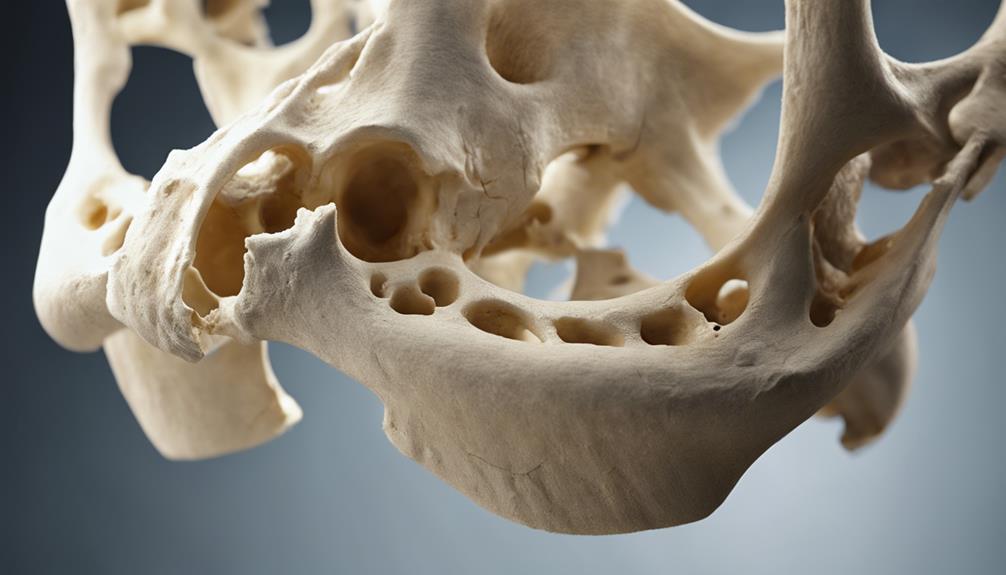As healthcare professionals, we frequently come across diagnostic codes like Z13.820, which are used for screening for osteoporosis.
But what lies beyond this initial classification?
Understanding the nuances of ICD-10 coding for osteoporosis can significantly impact patient care and reimbursement processes.
Let's explore how these codes not only facilitate accurate documentation but also play a vital role in improving outcomes for individuals at risk of osteoporosis.
Key Takeaways
- Z13.820 crucial for osteoporosis screenings
- Early detection prevents fractures, reduces costs
- Specific ICD-10 codes aid billing accuracy
- Detailed documentation supports accurate coding
ICD-10 Basics for Osteoporosis Screening
When conducting osteoporosis screening, the ICD-10 code Z13.820 is crucial for documenting encounters focused on this specific preventive measure. This code is essential for healthcare providers to accurately report screenings for osteoporosis, ensuring proper reimbursement and tracking of bone health assessments.
Utilizing Z13.820 allows for clear identification of patients undergoing screenings such as bone density evaluations, commonly done through a DEXA scan. By including this specific code in the patient's medical record, healthcare professionals can easily track and monitor osteoporosis screening efforts, promoting early detection and intervention to prevent fractures and complications associated with this condition.
Z13.820 falls under the Z00-Z99 range in ICD-10-CM, specifically designed for non-disease or injury circumstances like preventive screenings. Remember, when documenting encounters related to osteoporosis screening, using Z13.820 isn't only necessary for billing purposes but also aids in providing quality care by ensuring thorough documentation of bone health assessments.
Importance of Early Osteoporosis Detection

Transitioning from the focus on ICD-10 coding for osteoporosis screening, early detection of osteoporosis plays a critical role in preventing fractures and related complications. Identifying individuals at risk through screenings like DEXA scans allows for timely intervention and prevention strategies. Screening for osteoporosis, with an appropriate ICD-10 code for encounter for screening, is crucial for reducing the burden of fractures and related healthcare costs. Early diagnosis enables healthcare providers to devise tailored treatment plans and suggest lifestyle modifications to enhance bone health. Regular screenings aid in monitoring bone density changes over time, enabling adjustments in management strategies as needed.
| Importance of Early Osteoporosis Detection | ||
|---|---|---|
| Prevents fractures | Identifies at-risk individuals | Reduces healthcare costs |
| Enables timely intervention | Tailors treatment plans | Monitors bone density changes |
Understanding Osteoporosis ICD-10 Codes
How are osteoporosis ICD-10 codes crucial in clinical practice for accurate documentation and billing purposes? Osteoporosis ICD-10 codes, such as Z13.820, play a vital role in healthcare settings for several reasons:
- Specific Identification: ICD-10 codes provide a specific identification system for various conditions, ensuring accurate tracking and management of osteoporosis cases.
- Billing Accuracy: Proper coding ensures that healthcare providers bill accurately for services related to osteoporosis screening, leading to fair reimbursement for the care provided.
- Standardization: The International Classification of Diseases (ICD) system standardizes disease classification worldwide, promoting consistency in reporting and statistical analysis.
- Integration with Medical Devices: ICD-10 codes are essential for integrating medical devices and electronic health records, facilitating seamless information flow and enhancing patient care quality.
Understanding and utilizing osteoporosis ICD-10 codes is essential for healthcare professionals to streamline documentation processes, ensure correct billing practices, and improve overall patient care outcomes.
Top ICD-10 Codes for Osteoporosis Screening

Moving from the discussion on the significance of osteoporosis ICD-10 codes in clinical practice, understanding the top ICD-10 codes for osteoporosis screening is essential for accurate documentation and billing purposes in healthcare settings.
One of the key ICD-10 codes for osteoporosis screening is Z13.820, which was the second most common code used in 2021 for this purpose. Accounting for 14.40% of osteoporosis diagnoses, Z13.820 is a prevalent screening code specifically designed for encounters focused on screening for osteoporosis.
Importantly, encounters coded under Z13.820 for osteoporosis screening are exempt from Present on Admission (POA) reporting requirements. Healthcare providers rely on Z13.820 for proper billing and coding of osteoporosis screening procedures, ensuring that these essential services are accurately documented and reimbursed.
Staying informed about the top ICD-10 codes like Z13.820 is crucial for healthcare providers to streamline their coding processes and improve patient care.
Coding Tips for Osteoporosis Screening
To ensure accurate coding and billing for osteoporosis screening, healthcare providers must pay close attention to the proper utilization of ICD-10 code Z13.820. This code is crucial for indicating encounters specifically for screening for osteoporosis. Here are some coding tips to consider:
- Index Entries: When using Z13.820, refer to the ICD-10 index entries related to screening and osteoporosis to ensure proper coding.
- Two Main Codes: Familiarize yourself with the two main ICD-10 codes for osteoporosis screening, including Z13.820, as well as any additional specific codes that may be necessary.
- Documentation: Ensure detailed documentation of the screening encounter to support the use of Z13.820 and justify billing for the service.
- POA Exemption: Understand the Point of Origin for Admission (POA) exemption for Z13.820 when documenting osteoporosis screening encounters to avoid billing discrepancies.
Frequently Asked Questions
What Is the Diagnosis for Osteoporosis Screening?
We use the ICD-10-CM diagnosis code Z13.820 for osteoporosis screening. It helps in documenting encounters and getting reimbursements.
Detecting osteoporosis early is crucial for bone health management. Z13.820 falls within the Z00-Z99 range for non-disease or injury circumstances in ICD-10-CM.
Healthcare providers rely on Z13.820 to show encounters related to screening for various conditions, including osteoporosis.
What Is the Code for DEXA Screening?
We've got you covered with the code for DEXA screening! The specific ICD-10-CM code you need is Z13.820. This code is crucial for accurately documenting and billing encounters related to screening for osteoporosis through DEXA scans.
What Is the ICD-10 for Osteoporosis Check?
For osteoporosis checks, the ICD-10 code is Z13.820. This code helps healthcare providers document and bill for screening encounters related to osteoporosis.
Effective from October 1, 2023, Z13.820 falls under the Z codes range for encounter screenings. It's essential for reimbursement purposes and is part of the Z00-Z99 codes for screening diseases and disorders.
Healthcare professionals rely on Z13.820 to track and manage osteoporosis screening activities efficiently.
What Is Diagnosis Code Z13 82?
Diagnosis code Z13.820 is for 'Encounter for screening for osteoporosis.'
This code, effective from October 1, 2023, falls under the Z00-Z99 range in the non-disease or injury circumstances of the ICD-10-CM coding system.
It helps document encounters focused on osteoporosis screening for proper reimbursement and preventive care tracking.
This code is instrumental in ensuring accurate coding and billing for screening services provided to patients.
Conclusion
In conclusion, utilizing the correct ICD-10 codes for osteoporosis screening is crucial for accurate billing and documentation in healthcare settings. Early detection of osteoporosis is essential in managing the risk and preventing complications. By following coding guidelines and implementing screening practices, healthcare providers can effectively identify and address osteoporosis concerns.
Remember, proper coding is the key to unlocking successful osteoporosis management and improving patient outcomes.









